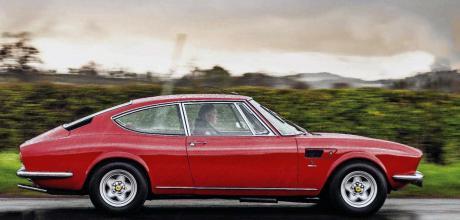1971 Fiat Dino 2400 Coupé
‘It feels timeless when driving on the open road’ The List Reader Peter Warren experiences his ‘ultimate Fiat’, the Dino Coupé. Words Andrew Noakes. Photography Laurens Parsons.
The List Your dream drive made real
Reader Peter Warren once owned a Fiat 130 Coupé, but fancied trying a Dino – so Classic Cars made it happen
Dino: top 10 drive made real ‘It’s a state of mind’ – CC reader Peter finally drives a Dino Coupé
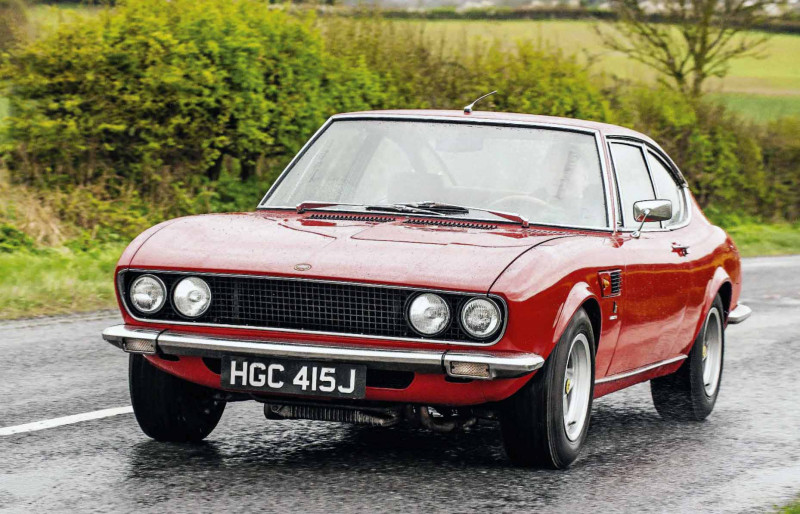
Somewhere in these tiny, twisty lanes, there is a classic car dealer with a Fiat Dino Coupé waiting for Classic Cars reader Peter Warren and I, but knowing it’s there and finding it are two different things. There’s no end of charming Cotswold villages and any number of picture postcard stone churches. Around every bend there seems to be a milk tanker or a massive tractor, the machines that make agriculture work around here. But this quaint corner of rural Gloucestershire isn’t giving up its secrets that easily – of Bertone-bodied, Ferrari-engined exotica there is no sign.
‘The torque means there’s little need to extend the V6 into the yellow sector of the rev counter’
Just as I’m giving up hope a flash of bright red catches my eye and there’s the Dino, the chrome bumpers sparkling in the sunshine as it waits in a courtyard alongside a handful of other cars under dust covers. We’ve found County Classics, where boss Andy Lerry has the Dino and a selection of other mouthwatering cars for sale, plus a few rare gems that make up his own private collection, from Fifties Fiats and Forties Americana through to a glorious, concours-winning 1966 Maserati Sebring.
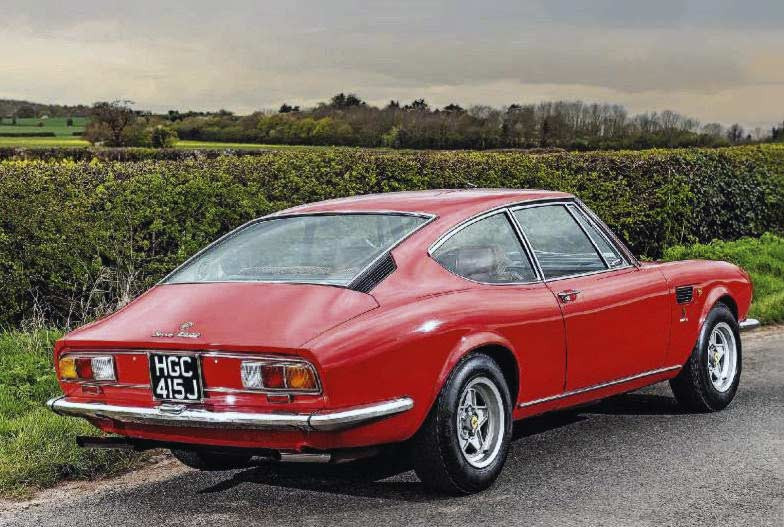
‘I’ve always been a petrolhead,’ says reader Peter. ‘There was a time when I had three cars – a BMW 530, Porsche 911 and Citroën SM. I have to admit that I couldn’t really do justice to them. You’ve got to garage them and keep swapping them over. Other classics that I’ve enjoyed in the past include a Chevrolet Corvette and a Fiat 130 Coupé. Though the latter shares some DNA with the Dino, it’s a very different kind of car. The 130 Coupé is basically a saloon car. It’s an armchair ride. Two doors, about 15ft long, three-speed automatic.’ The Dino is nearly a foot shorter, a substantial 170kg lighter, and is motivated by a smaller, revvier V6 driving through a five-speed manual gearbox. It promises to be a much livelier machine than the patrician 130 Peter is used to.
Peter eyes up the handsome lines of the Dino in front of us. ‘I’ve always lusted after these,’ he says. ‘It looks modern still, despite its age.’ Bertone styled the fastback Coupé, a steel monocoque like the Pininfarina-designed Spider, which was unveiled at the Geneva show in March 1967. ‘It has lean lines that are good from every angle. There’s a hint of aggression from the forward-leaning four-headlamp snout and a well-proportioned elegance created by the flowing curves over the wheels and the neatly resolved tail.’ Peter can’t wait to get behind its tasteful wood-rimmed steering wheel, and I can’t blame him.
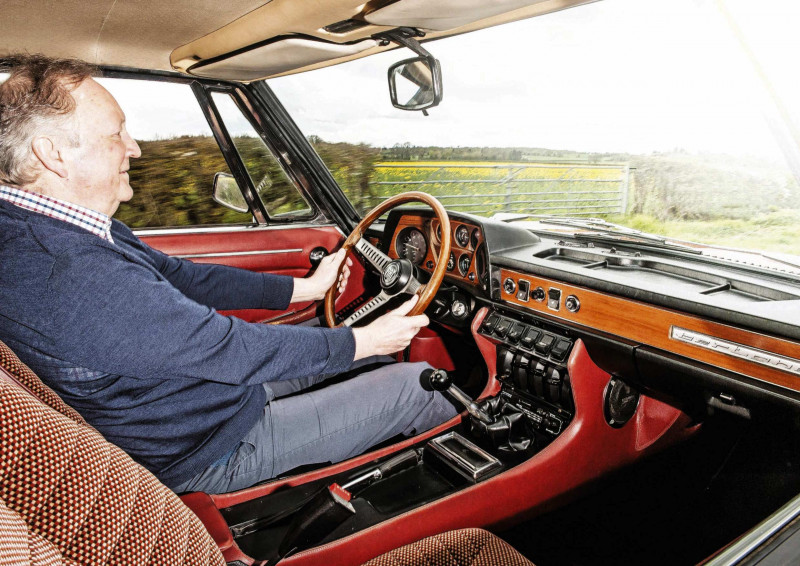
He settles into the driving seat and Andy talks him through the controls. ‘The steering is unpowered and when you’re going slowly it’s laughably heavy, so be prepared,’ he warns. Peter grips the steering wheel, ‘This wheel is a very Italian feature, a nice wood rim and perforated alloy spokes – it looks handsome and feels great.’ Behind it there’s a veneered plywood dash well stocked with legible black-on-white Veglia dials. The 9000rpm tacho and 250km/h (155mph) speedo, with their quaint fishtail needles, flank gauges for the oil and water temperature, oil pressure and fuel contents together with an analogue clock. A twist of the key and the V6 engine fires up with a lovely, bassy rumble through the big twin tailpipes, and soon Peter is nosing the Dino out of the gates and into the Gloucestershire countryside.
‘It takes a while to get used to it,’ he reports when we stop to get his first thoughts a few miles later. ‘It has a five-speed dog-leg gearbox, so it’s tricky to know which gear to be in sometimes.’ But he’s relishing the challenge presented by the unfamiliar gate pattern. ‘That’s the fun, isn’t it?’ he grins.
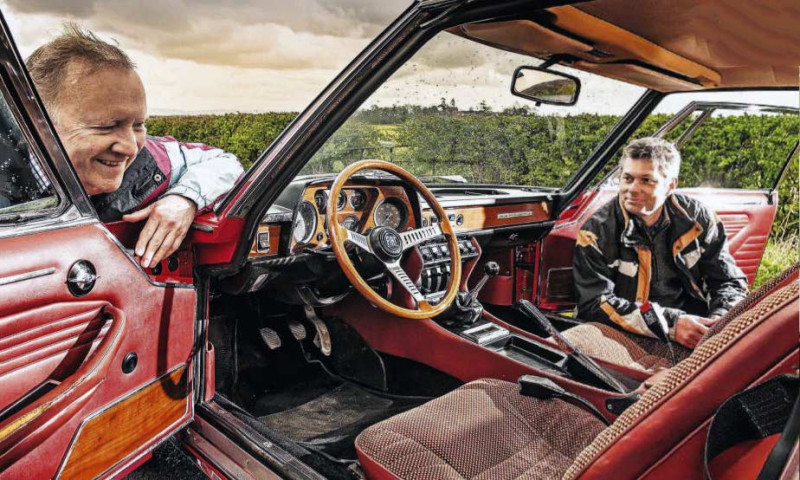
That dog-leg gearbox and the ‘Dino 2400’ badge on the back mark this out as a later version of a car that had been created as a way to homologate Ferrari’s V6 engine for Formula 2 racing, which required a production engine block with at least 500 units built. That was too many for Ferrari to handle, so it struck a cunning deal with Fiat to put the engine into a road car.
In 1969 the 2.0-litre V6 was replaced by a new 2.4-litre iron-block engine with an extra 20bhp and enough extra torque that the gearbox had to be upgraded to the stronger ZF unit with its dog-leg first gear. ‘The gear lever gate is quite narrow between second and third, so you can easily get fifth by mistake when changing up,’ Peter explains. ‘It doesn’t help that the lever is quite a stretch away, like the steering wheel.’
Peter’s getting to grips with the Dino now and pushing it harder, the V6 wailing away as he accelerates through the gears. Contemporary tests gave a 0-60mph time of just under nine seconds for the Coupé, about half a second shy of the lighter Spider. It’s respectable performance for its era, about the same as a BMW 2500CS E9. When we stop to take a look at the motor and raise the forward-opening bonnet we’re a bit disappointed by the sight. ‘The engine bay is dominated by that big grey airbox,’ Peter says.
‘It would be nice to get a glimpse of those three Weber carburettors. At least there are the bright orange cam covers on each bank of the engine. If you look carefully you can see the cylinder numbers and the engine’s firing order cast into the cylinder heads.
It has electronic ignition too – I believe it was the first production car to have it as standard.’ He’s right – it’s a capacitive discharge system that was developed by Magneti Marelli for the Ferrari Dino racing cars, hence its name – Dinoplex. The Fiat was the first roadgoing application, beating Ferrari’s own 206 Dino by a year. An ‘Emergenza’ switch on the side of the ignition unit engages a backup points system should the Dinoplex fail, which suggests the makers weren’t entirely convinced of the system’s reliability.
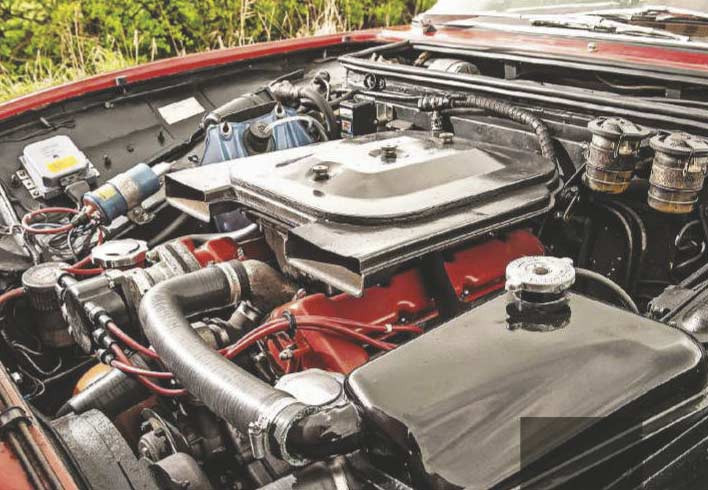
Peter loves the V6’s sound. ‘It’s got a beautiful bark,’ he says. ‘There’s also a particularly positive throttle response, and the car holds its own very well in modern traffic, with great acceleration. The extra torque of the 2.4-litre engine means there’s little need to extend the V6 into the yellow sector of the rev counter at 7250rpm and up to the redline at 8000rpm.
‘I’ve stopped using first gear now. You don’t need it – I realised you can pull away in second quite easily, and I’m using second, third and fourth most of the time. Fifth is like an overdrive. Getting into reverse is a little bit tricky sometimes. You’ve got to put your clutch foot right on the floor because the bite point is quite low. The relationship between the pedals is well judged, though, and the brakes are well up to the job.’
All the Fiat Dinos have double wishbone front suspension, but where the earlier Dinos have live axle and leaf springs at the back, the 2400s have a strut-type independent rear end, ‘Just like my old 130’, Peter says. ‘It looks like this car has Ferrari 308 five-spoke wheels in place of the original magnesium-alloy Cromodoras. It’s good to see it has period-style Michelin XWX radials – they have gripped well, even through that rain shower. The car is very surefooted, althought it’s also quite firm on the road. In the wet, it doesn’t hesitate or jump or wiggle at all.’
Like all Dinos this one is left-hand drive, which some drivers struggle with on UK roads, but it’s no problem for Peter. ‘I think left-hand drive is just an attitude of mind,’ he says. ‘I’ve had left-hand drive BMWs in this country before – so what? You’ve just got to look over your shoulder more.
‘But I have to say, while the steering is well-weighted and communicative on the open road, it’s proving to be hard work at parking speeds, just like Andy warned. The straight-arm driving position doesn’t help, either, making it harder to get decent leverage on the wheel rim. It was almost impossible to turn at one point back there. When the car’s not moving you’ve got the whole dead weight of all 1400-odd kilos against you. It’d be a challenge in a city. Once you’re moving it’s a lot easier to turn the wheel.’
The same is true of many classics with unassisted steering, of course – back in the day, new drivers were always taught not to turn the wheel when the car was stationary, but it’s an increasingly forgotten technique in an era where virtually all cars have power steering. ‘Modern cars do everything for you and it’s not such a pleasurable driving experience,’ Peter says. ‘People don’t learn to drive any more – they learn to press a few buttons on a computer.’
There would be little to keep technophiles occupied in the all-analogue Dino beyond electric front windows. ‘These must have been a rarity back in the early Seventies,’ Peter remarks. ‘The heating and ventilation system has only produced satisfactory results throughout the day after considerable trial and error with the control levers. But I suppose we could have taken the last resort and consulted the owner’s manual.
‘It’s a well-appointed interior with inviting, well-shaped seats trimmed in a tasteful check cloth. They’re very comfortable. There’s space for four people inside because the Coupé has an extended wheelbase compared to the Spider – though inevitably the fastback roofline compromises headroom in the back.’ That extra length, and the 120kg additional weight in the fixed-roof car, also gives the Coupé a more composed ride than the Spider. ‘I’m finding it very comfortable,’ Peter says. ‘I don’t feel like I’m in a sports car that’s shaking me about.’
We head back to County Classics, where Peter sums up the Dino’s appeal. Apart from the heavy low-speed steering and unfathomable heater controls, he’s thoroughly impressed. ‘It’s a beautiful car,’ he says. ‘It felt timeless when driving on the open road, and sure footed. It didn’t feel like a boy-racer-type driving experience – it’s a bit more sophisticated than that.’ It’s rare, too: fewer than 8000 Dinos were built and they were never officially imported to the UK. Dino guru Mark Devaney reckons there are around 75 in this country, which makes it scarcer today than the much more valuable 246 Ferrari with which it shares its engine.
This example, on sale for £55,000, must be one of the very best. ‘It’s solidly built, no squeaks or rattles, and spacious in front and back,’ Peter says, eyeing up the elegant Bertone shape one last time. It’s lovely – a proper thoroughbred. It definitely lived up to my expectations, and it keeps its place in my top ten. I’ve loved it!’
Thanks to Andy Lerry of County Classics (countyclassics.net)
TECHNICAL DATA 1971 Fiat Dino 2400 Coupé
- Engine 2419cc V6, dohc, three Weber 40DCNF carbs
- Max Power 178bhp @ 6600rpm
- Max Torque 159lb ft @ 4600rpm
- Transmission Five-speed manual gearbox, rwd
- Steering Rack and pinion
- Suspension
- Front: independent, double wishbone, coil springs, anti-roll bar.
- Rear: independent, semi-trailing arms, coil springs, anti-roll bar.
- Brakes Discs all round
- Weight 1400kg
- Performance 0-62mph: 8.7sec;
- Top speed: 130mph
- Economy 18mpg
- Cost new 4.1m Lire (£2717)
- Classic Cars Price Guide £22k-£50k
The Dino Coupé emphatically retains its spot in Peter’s dream garage. Orange cam covers and interesting details under the bonnet. Air box conceals the triple Weber carbs, to Peter’s disappointment. Peter found the Dino sure-footed to drive, even when the road was damp. Reader Warren (left) and writer Noakes enjoy the plush cabin Veglia speedo and tacho have unusual fishtail needles. Four-lamp nose and lipped Ferrari 308 wheels give the Fiat plenty of road presence.
‘There’s a hint of aggression from the forward-leaning four-headlamp snout and a well-proportioned elegance’
PETER’S DREAM DRIVE LIST
Ferrari F550 Maranello ‘One of the best looking Ferraris, and with reasonable manners for everyday driving.’
Alfa-Romeo Montreal ‘A charismatic flawed diamond. It seems Alfa was jealous of the Fiat Dino success and rushed out the Montreal. A stylish high-speed cruiser – quite un-Alfa-like!’
Dodge Charger ‘It’s just the meanest looking muscle car in the world. It’s a beautiful sounding engine, very fast. It’s just a proper muscle car. And then there’s the Bullitt appearance, of course.’
Fiat Dino ‘I’ve always thought it was such a cool car – the ultimate grand tourer from the Sixties and Seventies. It’s got power, class, style. It’s a very clever hybrid of Fiat and Ferrari.’
Maserati Mistral ‘Stylish grand tourer, looks very classy. The sort of car that you drive listening to Matt Munro singing On Days Like These.’
Bentley Continental S3 Flying Spur ‘About the smoothest of smooth cars. Electric windows, which were rare in those days. Beautiful lines.’
Sunbeam Tiger ‘Rare, very pacey, compact. A big V8 engine shoe-horned into a relatively small car, and an unusual sight these days.’
MG TC ‘I’ve got my eyes on a 1947 TC. I’ve always liked them. A mate of mine at university had one and I wished I could afford one. It’s a proper Mr Toad car – even though it’s flimsy and not very fast.’
Pontiac Firebird
‘One of my favourite muscle cars, not too outlandish to look at, fast and furious.’
Triumph GT6 ‘I had a TR6 so this is similar. Good balance, still looks good today, fast solid performer.’
PETER WARREN’S CAR CV
Style is clearly an attribute Peter values
FIAT 130 COUPÉ ‘Enzo’s favourite daily driver. I bought it from a dealer in Italy – I didn’t even go and see it. They had 48 pictures of it on their website so I was happy they weren’t trying to hide anything.’
CITROËN SM ‘I’ve always liked it. I bought it in Italy where most of them are. It was very advanced with the oleo-pneumatic suspension and five-speed gearbox. A beautifully designed object.’
MASERATI QUATTROPORTE ‘A beautiful car. It rode well and had proper road presence but was ruinously expensive to run. It needed new windscreen wipers – but you have to buy the motor as well, and it’s £500.’
CHEVROLET CORVETTE ‘I loved the shapely view from the driving position. It was not subtle, but had very cool lines, and was great in summer with the T-top roof panels removed.’
AUSTIN CHAMP ‘When I was a student in 1966, me and four other blokes drove one all the way to Istanbul, Turkey, 5000 miles. It was a huge adventure. I thought one day I’m going to have one.’


